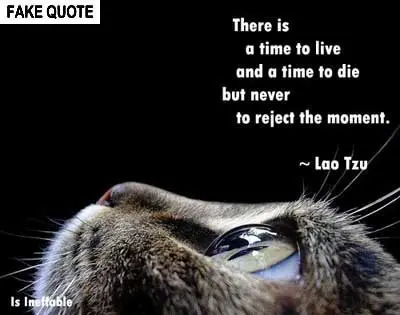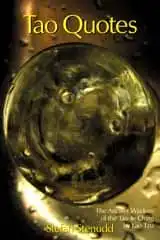Fake Lao Tzu Quote
"There is a time to live..."

This is NOT a quote from Tao Te Ching:
"There is a time to live and a time to die, but never to reject the moment."
The Book
The Taoism of Lao Tzu Explained. The great Taoist philosophy classic by Lao Tzu translated, and each of the 81 chapters extensively commented. Click the image to see the book at Amazon (paid link).
More about the book here.
|
Though accredited with this quote, Lao Tzu would insist that there is no specific time to live, but a way to do it — following Tao, the Way. That is all. Those who did not follow Tao were prone to rush through life, as stated in the beginning of chapter 50 of Tao Te Ching (my version):
We go from birth to death.
Three out of ten follow life.
Three out of ten follow death.
People who rush from birth to death
Are also three out of ten.
Why is that so?
Because they want to make too much of life.
|
90 of the most spread false Lao Tzu quotes, why they are false and where they are really from. Book by Stefan Stenudd. Click the image to see the book at Amazon (paid link).
More about the book here.
|
Lao Tzu also pondered the afterlife, but not in the conventional meaning. He wrote in chapter 33:
Those who die without being forgotten get longevity.
This line was for long misunderstood to imply there was something one could do to extend one's life far beyond the normal expectancy. The line was interpreted much like James Legge did in 1891:
He who dies and yet does not perish, has longevity.
But the wording of the two Mawangdui manuscripts from around 200 BC, discovered in the 1970s, made it clear that the long life was in other people's memories, and nowhere else.
This says the same as the old Norse proverb in Havamal, here in the 1875 translation by Rasmus Björn Anderson in Norse Mythology: The Religion of our Forefathers (page 143):
Cattle die,
Kindred die,
We ourselves also die;
But I know one thing
That never dies, --
Judgment on each one dead.
As for rejecting the moment, Lao Tzu would find it preposterous. How to do that? The moment is a quickly fleeing thing. He was clear about the folly of trying to resist how the world works, but that must be a process over time and not just a single moment. A moment is gone and immediately replaced by another. There is not much sense in pondering it. The word Tao, the Way, indicates that there is instead a direction and progression to consider.
The first part of this quote, about a time to live and another to die, is not unknown in the history of thought. It can be found already in the Bible. The beginning of chapter 3 of Ecclesiastes reads (King James Version):
To every thing there is a season, and a time to every purpose under the heaven:
A time to be born, and a time to die; a time to plant, and a time to pluck up that which is planted;
A time to kill, and a time to heal; a time to break down, and a time to build up;
A time to weep, and a time to laugh; a time to mourn, and a time to dance;
A time to cast away stones, and a time to gather stones together; a time to embrace, and a time to refrain from embracing;
A time to get, and a time to lose; a time to keep, and a time to cast away;
A time to rend, and a time to sew; a time to keep silence, and a time to speak;
A time to love, and a time to hate; a time of war, and a time of peace.
This part was used in the Pete Seeger song "Turn! Turn! Turn!," which became a hit with the Byrds in 1965. The chapter ends:
All go unto one place; all are of the dust, and all turn to dust again.
Who knoweth the spirit of man that goeth upward, and the spirit of the beast that goeth downward to the earth?
Wherefore I perceive that there is nothing better, than that a man should rejoice in his own works; for that is his portion: for who shall bring him to see what shall be after him?
It is not that far from what Havamal stated about the matter.
Another interesting perspective on the time for living and dying comes from the English politician Sir Henry Vane (1613-1662), quoted in The life and death of Sir Henry Vane, Kt., by George Sikes, from 1662 — the same year Sir Henry was executed for having collaborated with Oliver Cromwell (page 122):
There is a time to Live and a time to die. A good Death is far better and more eligible than an ill Life. A wise man Lives but so long as his Life is more worth than his Death.
Sadly, Sir Henry was not allowed to make that decision for himself.
The Roman emperor Marcus Aurelius (121-180 CE) had a somewhat similar take on the topic in Meditations, here in George Long's translation from 1874 (page 108):
Since it is possible that thou mayest depart from life this very moment, regulate every act and thought accordingly.
As for the quote examined in this chapter, I have not found any book containing it with the exact same wording. The closest thing to it is in Stephen Mitchell's 1988 Tao Te Ching version's beginning of chapter 50, to which I gave my version above. Here are his words for the same lines:
The Master gives himself up
to whatever the moment brings.
He knows that he is going to die,
and he has nothing left to hold on to:
no illusions in his mind,
no resistances in his body.
As so often, Mitchell allowed himself a substantial portion of freedom from the original text and its content. For more about Stephen Mitchell and his version of Tao Te Ching, see the chapter A good traveler has no fixed plans. Still, his version of chapter 50 is not likely to be the source of the quote. It deviates too much in form, though implying sort of the same meaning.
The quote is much more likely to be derived partly from the famous expression in Ecclesiastes, with an addition of its second part from someone with kind of a Zen mind. Its essential message is simply: live in the moment.
It can be compared to another fake Lao Tzu quote discussed on this website: "If you are depressed, you are living in the past. If you are anxious, you are living in the future. If you are at peace, you are living in the moment."
A Google search of the web indicates that the quote discussed here appeared in 2013, but its reappearance was scarce the following years. The spread seems mainly to be by memes, accrediting Lao Tzu. On Facebook, the quote popped up the year before, in November 2012. It was as a cat photo meme, ascribing the quote to Lao Tzu. The meme image file is actually slightly older, from September 18, 2012, so it was probably picked up from somewhere else. Unfortunately, I have not been able to find where.
Stefan Stenudd
September 21, 2020.
There are many more fake Lao Tzu quotes examined on this website.
Click the header to see a list of them.
Click the header to read a "fake" interview with Stefan Stenudd, the author of
Fake Lao Tzu Quotes.
My Taoism Books
Click the image to see the book at Amazon (paid link).
The Taoism of Lao Tzu Explained. The great Taoist philosophy classic by Lao Tzu translated, and each of the 81 chapters extensively commented.
More about the book here.
The Ancient Wisdom of the Tao Te Ching by Lao Tzu. 389 quotes from the foremost Taoist classic, divided into 51 prominent topics. Click the image to see the book at Amazon (paid link).
More about the book here.
Erroneous Tao Te Ching Citations Examined. 90 of the most spread false Lao Tzu quotes, why they are false and where they are really from. Click the image to see the book at Amazon (paid link).
More about the book here.
|
My Other Websites:
The 64 hexagrams of the Chinese classic
I Ching and what they mean in divination. Try it online for free.
The ancient Chinese life energy
qi (
chi) explained, with simple instructions on how to exercise it.
The many ancient and modern life force beliefs all over the world explained and compared.
Other Books by Stefan Stenudd
Click the image to see the book at Amazon (paid link).
The Greek philosophers and what they thought about cosmology, myth, and the gods.
The life energy
qi (also
chi or
ki) explained, with exercises on how to awaken, increase and use it.
Basic concepts of the peaceful martial art. Aikido principles, philosophy, and fundamental ideas.
Qi, prana, spirit, ruach, pneuma, and many other life forces around the world explained and compared.
Jungian theories on myth and religion examined, from Carl G. Jung to Jordan B. Peterson.
About me
I'm a Swedish author and aikido instructor. In addition to fiction, I've written books about Taoism and other East Asian traditions. I'm also an historian of ideas, researching ancient thought and mythology. Click the image to get to my personal website.

 Tao Te Ching
Tao Te Ching Now it's a book, too!
Now it's a book, too! Tao Quotes
Tao Quotes Cosmos of the Ancients
Cosmos of the Ancients Qi — Increase Your Life Energy
Qi — Increase Your Life Energy Aikido Principles
Aikido Principles Life Energy Encyclopedia
Life Energy Encyclopedia Archetypes of Mythology
Archetypes of Mythology Stefan Stenudd
Stefan Stenudd